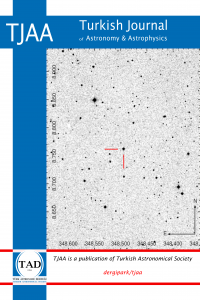Yıldızlarda Neler Oluyor? Kırmızı Budak Yıldızların Evrimine İlişkin Çıkarımlar
stars:distance, stars:evolution, stars:fundamental parameters, stars:interiors, stars:late-type, stars:oscillations
What is Going on in the Stars? Implications for the Evolution of Red Clump Stars
stars:distance, stars:evolution, stars:fundamental parameters, stars:interiors, stars:late-type, stars:oscillations,
___
- İbanoglu C., Çakırlı Ö., Sipahi E. 2018, NewA, 62, 70
- Yayın Aralığı: Yılda 2 Sayı
- Başlangıç: 2020
- Yayıncı: Türk Astronomi Derneği
Kepler Uzay Teleskobu ve ASAS Görüş Alanındaki Sefeid Türü Değişen Yıldızların Frekans Analizi
Mehmet Oğuzhan ERTURAN, Hasan AK
Ay Çarpma Parlamalarının Gözlenmesi
Güneş Civarındaki Anakol Yıldızlarının Işıma Gücü Fonksiyonunun Gaia Verileriyle Belirlenmesi
Doğu Deniz BULUT, Sabiha TUNÇEL GÜÇTEKİN
Cüce Eliptik Galaksilerin Doğası ve Yıldız Popülasyon Çalışmaları
Şeyda ŞEN AYDEMİR, Reynier F. PELETİER, Cahit YEŞİLYAPRAK
Kuazarlarda Kırmızıya Kaymanın Belirlenmesi: zFinder
Enes Selam KAÇAN, Seyit HÖKELEK, Nurten FİLİZ AK
Evrende Moleküler Bölgeler ve Astrokimya
Kataklismik Değişen Yıldızlarda Madde Transferinin Bileşen Yıldızların Evrimine Etkisi
Yıldız İç Yapı Modelleri için Yüzey Yama Modelleri
OPEA Modeli ile Güneş Aktivitesinde X-ışın Flare Davranışının Belirlenmesi
Kimyasal Sıra Dışı Yıldızların Element Bolluklarını Araştırmak İçin Yeni Bir Yaklaşım
